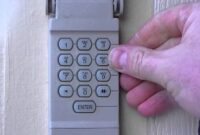Contents
How to Replace Garage Door Cable GarageDoorSalesNearme.Com | If you’re experiencing trouble with your garage door, you may be wondering how to replace the cable.
Whether it’s frayed or broken, this article will help you repair your garage door cable. In addition, you’ll learn how to identify a frayed or broken cable, and how to maintain your garage door cables to prevent problems down the line.
Continue reading to learn more. Once you’ve completed the steps, you’ll have no trouble reinstalling the cable and fixing any underlying issues.
How to Replace Garage Door Cable
#Repairing a Broken Garage Door Cable
There are a few signs that your cable is frayed or broken. Frayed cables are common, but they should not be ignored – they can cause the garage door to jam or lean, trapping your car or your family.
To prevent any serious damage, you should replace the cable as soon as possible. You can also use a visual inspection to identify any problems and get it fixed quickly. Fortunately, you don’t have to replace the entire cable – simply replace the broken cable with a new one.
First, make sure to turn off the automatic garage door opener. If you can’t do this, you can use clamps on the tracks to hold the door open for you while you work.
Be aware that the torsion springs in your garage door will be under considerable stress when the cable is broken. If you don’t release this tension, the springs could recoil, causing more damage. You can also call a professional to repair the cable instead of attempting to repair it yourself.
Depending on the size of your garage door, you can repair it yourself by using lubricant to loosen the screws that hold the cable drum in place.
Before tightening the screws, make sure that the cable lines up with the grooves in the drum. Be careful not to overtighten them, as they can strip the screws. In the end, the door should work perfectly once the cable is replaced.
To fix a broken garage door cable, it is necessary to remove the cable from the drum and lubricate it with silicone grease. A grease-based product is best to replace the cable, as it is more prone to fraying than a rubber one.
In addition to grease, the cable should be completely free of debris. Afterward, you should apply a new coat of paint and test the cable to make sure it’s working properly.
#Retaining Cables Prevent Debris From Flying Off
Retaining cables are essential for keeping your garage door in good working condition. These cables run along a series of pulleys.
These cables are usually attached to the bottom corners of the door and routed up to the torsion springs above. In some cases, the cables can become weakened due to moisture near the bottom of the door or faulty pulley bearings.
A weakened cable could break, causing damage to the door and anything underneath. To prevent this from happening, you should inspect the cables monthly.
Moreover, you should consider purchasing higher quality cables with zinc-aluminum coating, thicker diameter, and tighter thread construction.
Retaining cables are essential parts of garage doors with extension springs. They run vertically along the sides of the door and prevent broken pieces from flying off.
To prevent debris from flying off the garage door, retaining cables should be kept clean at all times. Dirt and lubricants can attract the cables and lead to their breakage. However, if you are not familiar with retaining cables, you should leave this task to the experts.
Retaining cables should be checked at least once every three years. A broken spring will cause the garage door to fall to the floor.
Therefore, it’s best to install two springs on your garage door if a spring breaks. This way, if one of the springs is broken, the second one will hold tension on the cables until you can repair it. Moreover, retaining cables should be replaced if the first one breaks down.
#Identifying a Frayed or Broken Cable
If your garage door is out of alignment, it may be time to replace the garage door cable. Frayed or broken cables can be easy to spot through close visual inspection. Look for fraying, corrosion, and rust.
You may also notice a faulty pulley mechanism. A faulty pulley mechanism will increase strain on the cable, accelerating wear and tear. To identify a frayed or broken cable, follow the steps below.
Check for loose cables or springs. If the cables are loose, they may not be connected correctly to the springs. If the cable is loose, it increases the risk of the garage door falling.
If the cable is broken, check the connections between the spring and the cable to determine whether it’s frayed or broken.
If the cables are frayed, replace the cables and springs as soon as possible to prevent further damage to the garage door.
Frayed cables or broken springs can also cause injury to people and property. A technician should be able to replace a frayed cable. Nonetheless, you should visually check cables for fraying or breakage on a monthly basis.
Even if the cable is just damaged, you can prevent further damage. You can easily replace a frayed or broken cable by getting in touch with a garage door technician.
A frayed or broken cable can also be caused by an improperly installed torsion spring. A poorly installed spring can cause uneven movement, and a damaged spring could fall to the ground.
The same is true of a broken door cable. In this case, you’ll need a second spring to hold tension on the cables until the spring is replaced. If one spring fails, you won’t have a backup spring to keep it up while the second spring does its job.
#Maintenance of Garage Door Cables
A typical issue with garage doors is the cable system. The cables run over a system of pulleys, drums, and spools. Over time, the cables may begin to deteriorate due to wear and tear and moisture near the bottom of the door.
If the garage door is out of adjustment, the cables may rub against other hardware, accelerating wear and tear. Visual inspection of cables can identify problems before they lead to failure.
A visual inspection of garage door cables can catch early signs of damage and wear and tear. Check for rust, dirt, and kinks. If any of these areas are visible, they should be fixed.
Additionally, keep the cables free from heavy lubricants, which attract dirt and other debris. If any of these issues occur, you should contact a garage door technician for repair. Keeping cables clean will prevent problems down the road.
A trained technician should evaluate the system and replace parts as necessary, including the cables. If a cable breaks, it should be replaced as soon as possible.
Other services include lubrication, adjustment, and safety testing. If the garage door struggles to open and close, or if it squeaks or shakes, it might need repair. As a rule of thumb, garage doors should not struggle, squeak, or show signs of wear.
Garage door cables work closely with the springs in the door. A broken spring creates additional tension on the cables, causing them to come off the drum. If the cables are loose, the door may become heavier and the motor may eventually burn out.
As a result, improper maintenance of garage door cables will increase the life expectancy of the system. However, there is no substitute for the expertise and care required by a professional to inspect cables regularly.
#Cost of Garage Door Cable Repair
A broken garage door cable can be dangerous. The excess tension it creates may snap the cable, rendering it unusable. Replacing it may cost you between $100 and $350.
Frequent repairs are another sign of a worn-out cable. In such cases, you should hire a repairman to inspect and repair your cable.
If you notice that your cable is frayed or cracked, consider replacing it instead. Otherwise, the cost of garage door cable repair could be much higher.
If you’re in the market for a repairman to repair your garage door cables, you should expect to pay about $140 to $200 for basic labor.
The basic labor required for the repair job includes planning, acquiring equipment, and preparing the work site. Basic replacement fasteners and sealants are included in the cost of materials.
Some professionals use specialty equipment for the job. These tools include a pneumatic framing nailer, mittsaw, and 3 1/4-inch electric planer.
Garage door cables wear over time and can snap completely. If you hear a screeching or whining sound from your garage door, it’s likely the cable is wearing out.
A cable repair will cost between $75 and $200. If you notice your garage door is lifting unevenly, it’s likely due to a broken cable.
In this case, you may need to replace the chain and pulley. The cost will vary based on the amount of damage, but it’s generally between $100 and $200.
A broken sensor may be a minor irritant, but it can pose a safety risk to small children. Fortunately, modern garage doors have sensors that will notify you if they are about to close.
A broken sensor may require rewiring or realignment and will cost anywhere from $150 to $200. Regardless of the cause of the problem, a repair is worth it. You’ll be glad you hired a professional.



